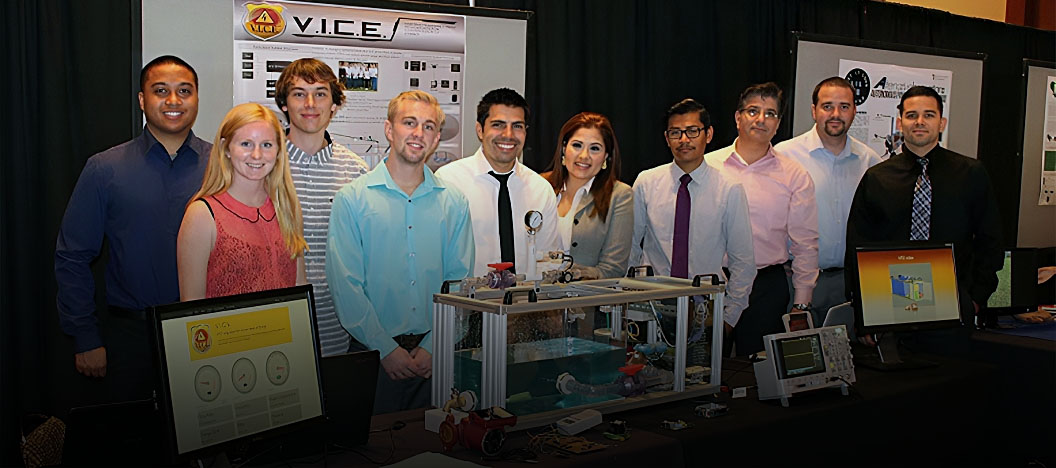Design Day 2021
Engineering Design Day 2021 will be held in a virtual format via Zoom on May 5, 2021 from 1:00pm - 4:30pm (PST). Please register to attend at https://sdsu.zoom.us/webinar/register/WN_zAnx12RgRi2ReAQ1KbUing. If you are unable to attend the virtual event, please see the Electrical & Computer Engineering projects for Design Day 2021 below.
Please visit our College of Engineering Design Day website, which has an archive of all of our Engineering Design Day events.
For previous Electrical & Computer Engineering Design Day projects, please visit:
Design Day Projects
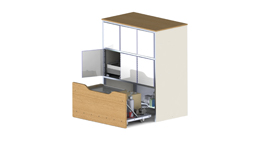
Automated microgreens growing appliance: designed to provide daily access to affordable microgreens. The project aims to provide the ideal growing environment for microgreens regardless of its surroundings. To achieve this our team developed an integrated controls system that oversees the watering, lighting, and climate of the growing environment through various electromechanical actuators, sensors, and custom PCB's. To ensure a consistent supply of microgreens to the user the device can grow up to five varieties.
- Team Members: Ali Alqaoud (ECE), Jose Baez (ECE), John Berger (ME), Abigail Dabu (ECE), Daniel Kenner (ECE), Max Merritt (ME), Thuyavan Sathiamurthi (ME), Conor Vasiliadis (ME), Elias Wooten (ECE)
- Advisors: Dr. S. Shaffar (ME), Dr. Y-K Teh (ECE)
- Sponsor: SDSU Zip Launchpad
- Automated Microgreens Growing Environment's Video
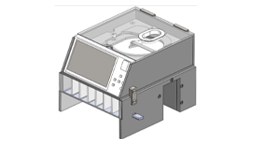
Team Pharmhouse will design and manufacture a pill dispenser that will be able to distribute a desired amount of pills to their respective days in both weekly and monthly pill organizers, including am and pm weekly containers. The dispenser will also be able to be compatible with pills of a variety of shapes and sizes, as it is common for users to take multiple unique pills per day. The design will accommodate users with impairments such as arthritis, color-blindness, and various upper extremity issues.
- Team Members: Musaed Albaghdadi (ECE), Naser Alfaresy (ME), Jacob Martinez (ECE), Chandler Meziere (ME), Sean Myers (ME), Tony Nguyen (ECE), David-Paul Sabado (ME), Jeff Smith (ECE), Micah Spence (ME), Jennifer Thai (ECE)
- Advisors: Dr. S. Shaffar (ME), Prof. B. Dorr (ECE), Ms. Annemarie Orr (QL+)
- Sponsor: Quality of Life Plus
- Automated Prescription - Pill Dispenser's Video

The objective of this project is to design, fabricate and demonstrate a water bottle refilling station that elminates water spillage normally encountered with traditional stations. The station employs an infrared sensor to detect a bottle, along with a microphone that detects a predetermined rate of change in the cavity resonance frequencies providing key information on when the bottle is full. Once the signal is detected indicating a full bottle, a microcontroller automatically shuts off the flow of water thus preventing overflow.
- Team Members: Nathan Behymer (ME), Ahmed Bohamad (ECE), Alberto Gomez-Flores (ME), Lydia Keaty (ME), Nguyen Pham (ECE), Erick Pompa (ECE), Ivan Santana (ME), Stephanie Suarez (ECE), Mohamad Zeidan (ECE)
- Advisors: Dr. S. Shaffar (ME), Prof. B. Dorr (ECE)
- Sponsor: Prof. Barry Dorr
- Automatic Acoustic Water Bottle Filling Station's Video
- Automatic Acoustic Water Bottle Filling Station's Website
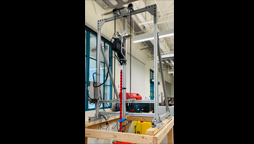
The ARES system is SDSU's submission to NASA's 2021 RASC-AL Moon to Mars Ice Prospecting Challenge with the goals of developing technologies capable of extracting water on the Moon and Mars and advancing the critical knowledge needed to further solar system exploration. ARES was designed as a prototype capable of extracting water from ice deposits buried beneath simulated lunar or Martian soil, identifying and mapping subsurface layers, and extracting water from a 600-pound ice block in a simulated off-world test bed.
- Team Members: Humood Alghunaim (ECE), David Bunson (ME), Alan Clemenson (ECE), Jesus Figueroa (ME), Matthew Gonzalez (ME), Jonathan Maravilla (ECE), Ryan Marmion (ECE), Brandon Mosburg (ECE), Krysta Rhodes (ME)
- Advisors: Dr. S. Shaffar (ME), Prof. B. Dorr (ECE)
- Sponsor: NASA
- Aztec in-situ Resource Extraction System's Video
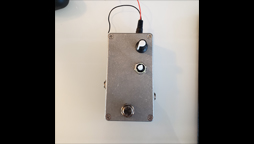
DIGIMUSER is a digital vocal effect processor “stompbox” that applies a variety of real-time signal processing algorithms to alter the voice of a singer. DIGIMUSER uses a microcontroller and user controls to digitally apply vocal effects such as filters, delays, distortions, and modulations. DIGIMUSER takes a standard dynamic microphone as input and outputs to an amplifier or additional audio processing devices. To put it simply, DIGIMUSER gives anyone an entire effects studio right in the palm of their hand.
- Team Members: Suaod Alhajry, Luke Kennard, Angel Martinez, Danielle Stewart, David Pierce Walker-Howell
- Advisor: Prof. K. Arnold
- DIGIMUSER - Vocal Effects Processor's Video
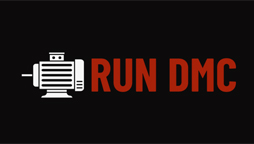
Motor Control is a challenge for many people taking on their first projects. Our team has designed a digital motor control that will allow a user to set the speed of a low voltage brushed DC motor and then the controller will maintain that speed even when the motor meets resistance. Think of it like cruise control for a small motor. Our team built this controller as an example for future students to follow when they decide to use motors in their own projects.
- Team Members: Lucas Adams, Ahmad Alawadhi, Cody Allen, Ghozlan Fagerah, Surendra Mahida, Conan Poppe
- Advisor: Prof. B. Dorr
- Sponsor: Self-Sponsored
- Digital Motor Controller's Video

Helios gives smaller consumers the opportunity to use an energy management system that large corporations utilize. It maximizes consumer profits with peak shaving and plans ahead for future weather conditions. Power usage is monitored with CAISO and weather conditions are pulled from OpenWeather. Helios will be able to intelligently switch between using power stored in batteries or power from the grid depending on the algorithm.
Here’s to a greener future! See you there.
- Team Members: Eissa W M A A Boland, Romilene Cruz, Stephen Malolepszy, Juan Carlos Orlando, Attila Rakosi
- Advisor: Prof. K. Arnold
- Sponsor: Prof. Ken Arnold, HiTech EdVentures
- Energy Management System's Video
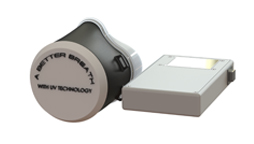
This team has designed an innovative facemask that incorporates a UV light sterilization system coupled with a filter to inactivate airborne pathogens including SARS-CoV-2.
- Team Members: Victor Guzman (ME), Brandon Hoang (ECE), Ryan Malone (ME), David Nikiforov (ECE), Nathan Pennington (ECE), Faud Siraj (ECE), Sophia Smith (ME), Breanna Tang (ECE), Raven Tomas (ECE), Tyler Young (ME)
- Advisors: Dr. S. Shaffar (ME), Prof. B. Dorr (ECE)
- Sponsor: SDSU, Mechanical Engineering
- Face Mask With Active Virus Control's Video
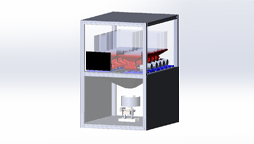
There is no vending machine on the market that automatically dispenses a custom granola mixture. This kiosk will allow the user to choose from a variety of granola bases and toppings through a user interface and have the ingredients mixed and delivered to them. Aztec Granola Factory is tasked with designing and manufacturing the architecture and all the major subsystems of the kiosk. This includes the 80/20 frame, ingredient storage containers, dispensing valves, and mixing/measurement mechanism.
- Team Members: Antonio Avila Ramirez (ME), Joseph Dawisha (ME), Mark-yves Gaunin (ECE), Marc Gordon (ME), Winston Liew (ECE), Austin McElrone (ECE), Ezra Simpson (ME), Sudarshan Suresh Babu (ECE), Naomi Tewolde (ECE)
- Advisors: Dr. S. Shaffar (ME), Dr. Y-K. Teh (ECE), Prof. B. Dorr (ECE), Mr. M. Bruno (ECE), Mr. Dusty Fisk (D&K Engr)
- Sponsor: D&K Engineering
- Granola Kiosk's Video
Location tracking within a building is difficult with GPS or similar technologies; our team offers an indoor location-tracking solution through the use of Bluetooth Low Energy (BLE). Within a predefined grid, we make use of mobile and anchor nodes that send RSSI values that serve as the input to a machine learning algorithm, which predicts the location of the mobile node based on said RSSI values. A GUI is used to visualize the mobile node's location every 10 seconds, with the ability to replay past locations.
- Team Members: Leo Chatterton, Hada Marabeh, Tristan Richmond, Zach Rocha, Sri Harsha Shatagopam
- Advisor: Dr. B. Aksanli
- Sponsor: Mr. Antony Brock, Transportation Security Administration
- Location Tracking Through Bluetooth Low Energy's Video
The MPPT will extract the maximum amount of power from a photovoltaic (PV) solar panel and provide the user with a constant voltage under various weather conditions. While tracking voltage and current from the input and output, the system will monitor ambient temperature and irradiance conditions and update the user via a TCP socket interface.
- Team Members: Daniel Baltazar, Travis Blake, Ryan Dial, Keelan Gloria, Anne Vu
- Advisor: Prof. K. Arnold
- Sponsor: Prof. Ken Arnold, HiTech EdVentures
- Maximum Power Point Tracker's Video
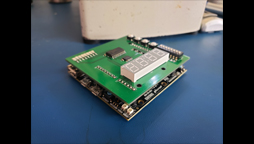
The current pandemic of COVID-19 has brought a halt to in-person instruction for both lectures and labs. As a consequence, students can no longer participate in hands-on labs, losing the real-world experience of having to set up and troubleshoot their lab equipment. My Desk Bench enhances both the experience of remote labs and a student’s learning by providing some missing functionalities or tools of in-person labs. It is intended to serve ECE students taking digital circuits and electronic labs.
- Team Members: Bashar Alali, Larissa Almendares, Shoya Ito, Armaan Kafaipour, Muiz Kareem
- Advisor: Prof. K. Arnold
- Sponsor: Prof. Ken Arnold, HiTech EdVentures
- My Desk Bench's Video
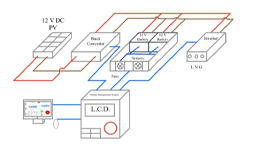
This project demonstrates a renewable microgrid which consists of an independent, rechargeable battery storage and a solar PV charging system. The system supplies power to DC and AC loads. The battery is charged by the solar panel, and monitored by a microcomputer. The sensors’ data is stored and processed through the microcomputer which can be used to display system information to the user through a laptop or on its integrated screen.
- Team Members: Cristian Borquez, Matthew Clark, Daniel Ghanim, Jamilla Thomas, Benjamin Tran, Eric Valle
- Advisor: Dr. C. Mi
- Sponsor: Mr. Sam Bustillos, SDG&E
- SDSU Solar Battery System's Video

Our goal is to design a smart mirror that makes everyday life a bit easier whether that is through putting all your notifications in one place or as an entertainment center. Features include: an LCD screen displaying notifications such as weather and stocks, an intercom system, clap activated lights, and built in speakers with corresponding music reactive LED strips. The Smart Mirror embodies the idea of technology providing numerous functions to simplify and entertain individuals, all in one centralized place.
- Team Members: Enes Basbug, Eduardo Cadena, Glorianne Francavilla, Brandon Lee, Angelo Dominic Navarro
- Advisor: Dr. H. Töreyin
- Smart Mirror's Video
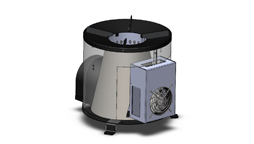
This senior design project is tasked to design and build a Tier 4 approved, bio-fueled cook stove that incorporates Hi-Z’s thermoelectric technology to support two fans and electrical outlet. The cookstove is to be deployed to third world countries to families that use biomass as their main source of fuel. The purpose is to reduce emissions, improve efficiency and create a source of electricity in areas that have limited access to power. The system comes equipped with data logging technology to display temperature and CO.
- Team Members: Alyaa Alkharji (ECE), Josh Birkett (ECE), Agustin Cedeno-Rodqriguez (ECE), Joel Edquiban (ECE), Sophia Nitkey (ME), Jason Schwartz (ECE), Alexander Sprague (ME), Reve Zumarraga (ME)
- Advisors: Dr. S. Shaffar (ME), Dr. Y-K. Teh (ECE)
- Sponsor: SDSU Zip Launchpad
- Thermoelectric Module-based Cookstove's Video
The Tired Tracker device was created as a proof of concept to the Transportation Security Administration (TSA) for a centralized system to allow users to view their fatigue level in real time by recording biometric data and transmitting it to an Android application over Bluetooth. The physical device consists of a small wearable embedded system strapped to the user’s wrist which collects body temperature, heart rate, and arm motion data in a non-intrusive way. An accompanying app analyzes the data and displays the user’s fatigue level on a scale of 1 (low) to 10 (high).
- Team Members: Andrew Birn, Fadi Georges, Shan Kureshy, Alkawther Mirza, Arman Shah
- Advisor: Dr. B. Aksanli
- Sponsor: Transportation Security Administration
- Tired Tracker's Video
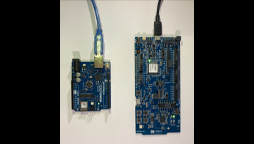
This system will allow the Transportation Security Administration (TSA) to measure wait times in screening queues. It uses a Bluetooth Low Energy (BLE) system consisting of beacon devices and anchors. Beacon's are given to and carried by airline passengers when they enter the TSA security line. Each beacon will record the time it takes for a passenger to pass through the line. Once the beacon is returned to TSA, it will transmit time start, time end, and overall time elapsed to anchor devices with WiFi capability that will host the data for TSA to monitor average security waiting times.
- Team Members: Danielle Drinko, Gary Tong, Cesar Oliva, Liam Weinfurtner
- Advisor: Dr. Y. Ozturk
- Sponsor: Mr. Antony Brock, Transportation Security Administration
- TSA Security Timers's Video
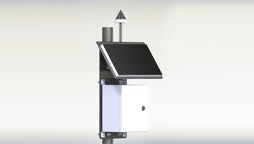
This team was tasked by the USAF at Ellsworth AFB to alert the security team at the base of an unmanned aerial vehicle (UAV) intrusion into the Ellsworth operational airspace. This team has designed a counter-UAV system capable of detecting the acoustics emitted by multi-rotor drones. In order to provide year-round surveillance, the system has been designed to utilize solar power and operate during the possible harsh weather conditions in South Dakota.
- Team Members: Brian Balsama (ECE), Rominique Borja (ECE), Blake Downey (ECE), Nick Fazio (ME), Luke Larochelle (ME), Christian Moreno (ECE), Isaiah Pico (ECE), Perla Ramirez (ME), Arturo Urbano (ME), Lilian Vu (ECE)
- Advisors: Dr. S. Shaffar (ME), Prof. Barry Dorr (ECE), Dr. Thad Welch (Boise State Univ), Dr. John Wood (NIWC, Pacific)
- Sponsor: U.S. Dept. of Defense, National Security Innovation Network
- USAF Counter Unmanned Aerial System (Drone) Solution's Video
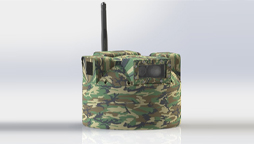
To create a small ground sensor capable of covertly monitoring remote areas in real-time with wireless user accessibility. Marines require a networkable, lightweight, disposable and user-friendly device that is capable of monitoring an evolving battlespace. These ground sensors shall be dispersed by hand along key locations to detect possible adversaries by methods of acoustics, visuals and motion. This device shall provide key information to the consumer to aid in their decision-making.
- Team Members: Nicholas Balagtas (ME), Joshua Barnard (ME), Blake Borskey (ECE), Koa Cabling (ME), Donnel Endaya (ECE), Raylan Jasec Gonzales (ECE), Paul Vincent Guiriba (ECE), Jakob Lepur (ECE), Henry Segura (ME)
- Advisors: Dr. S. Shaffar (ME), Prof. B. Dorr (ECE), Mr. Michael Hard (NSIN)
- Sponsor: U.S. Dept. of Defense, National Security Innovation Network
- USMC Small Ground Sensor's Video

